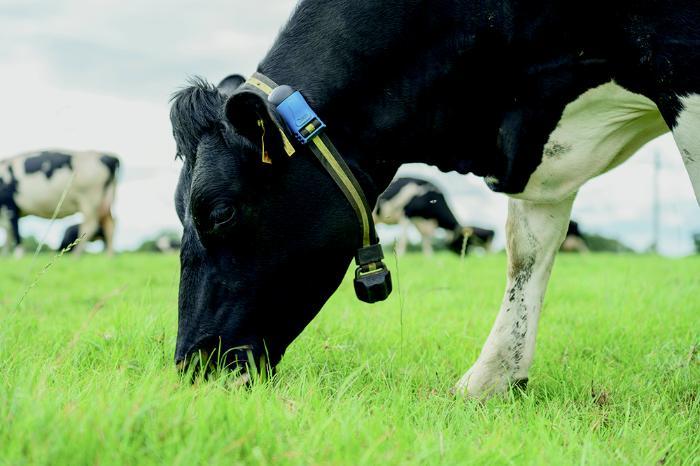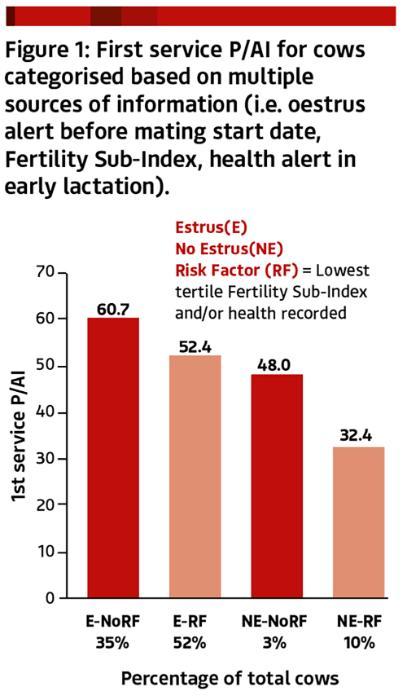12 June 2025
Milking the data
Leveraging data from technologies offers farmers a unique opportunity to enhance the productivity, sustainability and welfare of Irish pasture-based systems.

Credit: MSD Animal Health
Cows that show signs of heat before the breeding season are significantly more likely to become pregnant, a finding that’s helping farmers in seasonal-calving systems boost fertility and maintain a tight, profitable calving pattern.
In recent years, the industry has adopted new technologies to enhance the efficiency and management of pasture-based dairy production systems. Sensors – such as collars, ear tags, or boluses – that measure activity and rumination to detect oestrus (heat) and health events are becoming increasingly common on farms. These automated systems offer an alternative to traditional, labour-intensive methods of reproduction and health management.
In addition, genotyping and milk recording have grown in popularity. Approximately 20% of dairy cows in Ireland are monitored using behaviour-monitoring technologies, 39% are part of genomic testing programmes, and 68% are included in milk recording. This reflects a significant shift towards data-driven herd management.
The vast amount of data generated by these technologies presents a major opportunity – but it is essential that farmers and the industry use this data effectively to support informed decision-making. Teagasc researchers Emily Sitko and Stephen Butler, in collaboration with MSD Animal Health, are focused on using data to improve how breeding is managed on seasonal, pasture-based farms.
Turning technology into strategy
“More and more farmers are turning to data to improve breeding performance and make dairy farming more efficient and sustainable,” explains Emily. “Several studies in confinement systems have shown that individual cow data can be used to classify cows into subgroups based on fertility potential.”
Tailoring management practices to these subgroups has been shown to improve herd performance, profitability and overall outcomes compared with a one-size-fits-all approach.
For example, cows with higher fertility potential may benefit from artificial insemination (AI) at detected oestrus and are good candidates for sex-sorted semen. In contrast, cows with lower fertility potential may benefit from synchronisation and timed AI, and are better suited for receiving beef semen. However, this approach has not yet been evaluated in pasture-based systems.
To address this gap, Teagasc, in collaboration with MSD Animal Health, has launched a project to develop a precision reproductive management decision-support tool tailored to seasonal-calving, pasture-based farms. Since the first step in developing such a tool is identifying predictors of reproductive performance, the initial phase of the project has focused on exploring associations between cow-level factors and reproductive outcomes. Data were collected from over 8,500 lactations across 21 commercial herds in 2022 and 2023, including genomic information, calving and insemination records, milk production, and health and oestrus alerts from an automated activity monitoring system.
Cow fertility predictors
Several key factors were strongly associated with reproductive performance. Cows with at least one oestrus alert before the start of the breeding season had higher pregnancy per AI (P/AI) and conceived sooner (51% and 23 days) compared with cows that had no oestrus alert (37% and 33 days).
As the Fertility Sub-Index increased, so did the likelihood of pregnancy to first AI. Cows in the highest tertile for Fertility Sub-Index (over €117) had the best results (54% P/AI and 26 days to pregnancy), compared with those in the middle (€89 to €117; 48% and 28 days) and lowest tertiles (under €89; 34% and 32 days).
Health status also played a role. Cows with two or more post-calving health alerts had lower P/AI rates and took longer to conceive (43% and 29 days) compared with cows that had no health alerts (48% and 27 days).
Lactation number mattered too. First-lactation cows had better outcomes (48% and 26 days) than cows in their fourth or later lactations (43% and 30 days), with second- and third-lactation cows falling in between.
Emily says: “It’s clear that combining multiple predictors helped identify subgroups of cows with more pronounced differences in reproductive performance than when using a single factor alone.”
For example, combining oestrus alert data with Fertility Sub-Index and health alerts created subgroups with significantly different first-service pregnancy rates. These findings highlight the potential of using precision technology data to support more targeted, effective reproductive management.

Figure 1: First service P/AI for cows categorised based on multiple sources of information (i.e. oestrus alert before mating start date, Fertility Sub-Index, health alert in early lactation).
The future of breeding
With a clearer understanding of the cow-level factors most useful for creating fertility-based subgroups, the next phase of the project will focus on designing management strategies to optimise the performance of each group – and ultimately, the whole herd.
Specifically, researchers will explore how to best allocate sexed and beef semen based on fertility potential, identify cows that could benefit from hormonal treatments and maximise reproductive performance through more precise AI timing.
“These strategies aim to support a compact calving pattern and produce a high-merit calf crop – all of which contribute to greater sustainability,” adds Emily.
The final phase of the project will include on-farm trials to assess how the decision support tool affects reproductive performance and profitability, compared with traditional breeding approaches.
These findings emphasise the value of integrating precision technology data into reproductive management. Key predictors identified include oestrus expression before the mating start date, Fertility Sub-Index, health alerts, and parity. Ongoing research will evaluate the impact of the decision support tool on the performance and profitability of Irish pasture-based dairy farms.
Glossary
Milk recording — Regular measurement of how much milk each cow produces, along with its composition and quality, to help improve herd management and breeding decisions.
Oestrus/“heat” — the time when a cow is fertile and ready to be bred.
Genotyping/Genomic testing — Incorporating animal DNA information to predict traits like fertility, milk yield, and health.
Seasonal calving — a system where cows are bred to give birth during a specific time of year, often to match peak grass growth with peak herd demand for feed.
Sexed semen — semen that has been sorted to increase the chances of producing either a male or a female calf.
Funding
We gratefully acknowledge the farmers that participated in the research and thank MSD Animal Health for the support. The research was funded by Dairy Research Ireland Dairy Levy Trust.
Contributors
Emily Sitko, Research Officer, Teagasc Moorepark. emily.sitko@teagasc.ie
Stephen Butler, Principal Research Officer, Teagasc Moorepark.
